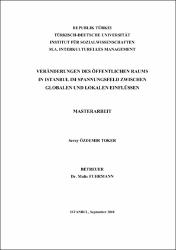| dc.contributor.advisor | Fuhrmann, Malte | |
| dc.contributor.author | Özdemir Toker, Seray | |
| dc.date.accessioned | 2020-03-06T11:50:45Z | |
| dc.date.available | 2020-03-06T11:50:45Z | |
| dc.date.issued | 2018 | |
| dc.identifier.citation | Özdemir Toker, Seray. (2018). Veränderungen des öffentlichen raums in İstanbul im spannungsfeld zwischen globalen und lokalen einflüssen. Türk-Alman Üniversitesi, Sosyal Bilimler Enstitüsü, İstanbul | en_US |
| dc.identifier.uri | https://hdl.handle.net/20.500.12846/47 | |
| dc.description.abstract | During the controversy of global and local development processes in recent years there has been a downright memory-boom in the public space of many metropolises. Memory as the essential precondition for the process of remembering, describes a fabric that contains the complete knowledge from the past to the present, it represents a media for storage and retrieval of information. Based on the research of the sociologist Maurice Halbwachs and the historian Pierre Nora the research couple Jan und Aleida Assmann developed a theory about the collective memory and the memory space. This theory is especially focusing on the construction processes of a national memory and the interactions between the actors. It also examines the aspect of how collective memory can built the foundation for the coherence of a community and which role spaces play as media of memory in the process of national memory production. This thesis is aiming on answering the question if the theory developed by the research couple Jan und Aleida Assmann can be used to describe the special objectivations of the Istanbul quarter of Eyüp in the Turkish context of culture of remembrance. A literature analysis of the memory theories of the mentioned authors provides the necessary foundation for the analysis of the applicability of the theory of Jan and Aleida Assmann to the example of Eyüp. Before starting with the analysis, the term Neo-Ottomanism, which is specific for Turkish culture of remembrance, is described with it sociocultural, political and historical factors of development. After that the substantial contents of Assmanns theory will be analyzed utilizing Eyüp as example for special objectivation of Turkish culture of remembrance. The conclusion evaluates the facts and findings in order to answer the initial question of this thesis. This shows that Assmanns theory can be applied to the Turkish context and that strong tendencies for the production of a cultural memory moderated by governmental bodies can be observed. Thus, this thesis contributes to the scientific discussion by describing the transformability of the national memory as identity-forming hallmark of a Nation in the Turkish context. | en_US |
| dc.description.abstract | Son yıllarda birçok metropolün kamusal alanında, global ve yerel gelişim süreçleri arasındaki çatışmada başlı başına bir hafıza patlaması kaydedilmiştir. Hatırlama sürecinin bir ön koşulu olarak bellek, geçmişten günümüze kadar olan tüm bilgileri içeren bir yapıyı tanımlamakta ve bilgiyi saklamanın ve ona ulaşmanın bir aracı olarak işlev görmektedir. Araştırmacı çift Aleida ve Jan Assmann, sosyolog Maurice Halbwachs ve tarihçi Pierre Nora’nın çalışmalarını temel alarak, toplumsal hafıza ve hafıza alanları hakkında, süreçleri başta ulusal bir hafızanın oluşması ve münferit aktörler arasındaki etkileşimler aracılığıyla araştıran kendi teorilerini geliştirmişlerdir. Burada, toplumsal hafızaların toplulukların bütünleşmesine nasıl temel teşkil ettiğine ve mekânların ulusal belleğin üretim sürecindeki uzaysal bellek aracı olarak hangi anlamı ifade ettiklerine odaklanılmaktadır. Bu çalışma, Assmann teorisinin Türk bağlamına uygulanabilirliğini, günümüz Türk anma kültürünün mekânsal bir tasviri olarak İstanbul'un Eyüp ilçesi örneği üzerinden değerlendirmeyi amaçlamaktadır. Bu amaç doğrultusunda, adı geçen yazarların hafıza teorileri, Assmann teorisinin elde edilen bulgular temelinde vaka çalışmasına uygulanabilirliğinin analiz edilmesine yönelik bir literatür analizi aracılığıyla incelenmektedir. Uygulanabilirlik incelenmeden önce, anma kültürünün sosyokültürel, politik ve tarihsel faktörlerinin yanı sıra anma kültürünün Türklere özgü bir ifadesi olarak Neo-Osmanlıcılık konsepti dikkate alınmıştır. Akabinde Assmann'ın hafıza teorisinin temel içerikleri, güncel Türk anma kültürünü mekânsal olarak nesnelleştiren Eyüp örneği üzerinden analiz edilmiştir. Sonuç olarak, elde edilen somut bilgiler ve sağladıkları bulgular, bu makalenin başında formülize edilen soruyu tartışmak üzere irdelenmektedir. Böylelikle Assmann’ın hafıza teorisinin Türk bağlamı üzerindeki uygulanabilirliği ortaya konulmuştur. Araştırmacı Assmann çifti tarafından tanımlanan toplumsal hafıza ile ilgili olarak, devlet tarafından yönetilen bir kimliğin inşasına dair bariz eğilimler göze çarpmaktadır. Dolayısıyla bu çalışma, ulusal hafızanın dönüştürülebilir olmasının ulusal kimlik değişiminin bir özelliği olarak Türk bağlamı üzerinden ortaya konulmasına katkı sağlamaktadır. | en_US |
| dc.language.iso | deu | en_US |
| dc.publisher | Türk-Alman Üniversitesi | en_US |
| dc.rights | info:eu-repo/semantics/openAccess | en_US |
| dc.subject | Anma kültürü | en_US |
| dc.subject | Toplumsal hafıza | en_US |
| dc.subject | Neo-Osmanlıcılık | en_US |
| dc.subject | Culture of remembrance | en_US |
| dc.subject | Collective memory | en_US |
| dc.subject | Neo-Ottomanism | en_US |
| dc.subject | Erinnerungskultur | en_US |
| dc.subject | Neo-Osmanismus | en_US |
| dc.title | Veränderungen des öffentlichen raums in İstanbul im spannungsfeld zwischen globalen und lokalen einflüssen | en_US |
| dc.type | masterThesis | en_US |
| dc.relation.publicationcategory | Tez | |
| dc.contributor.department | TAÜ, Sosyal Bilimler Enstitüsü, Kültürlerarası Yönetim Ana Bilim Dalı | en_US |
| dc.contributor.institutionauthor | Özdemir Toker, Seray | en_US |

















